AVE MARIA -- Xylographic music broadside combining the traditional antiphon 'Ave Maria' in German with 'Maria du pist genaden vol', plainchant. [Upper Germany, possibly Nuremberg or Augsburg: c.1490-1500]. Half-sheet chancery broadside (189 x 281mm). Five 5-line staves with plainchant neumes notation and German text, C and F clef, strokes indicating correspondence between text and notes, thick single outer border, large opening initial coloured in yellow. No watermark. (Minor expert repairs on verso, single small wormhole, shaved at left side with some loss of rule border.) Modern solander case. Provenance : previously pasted together with a composite sheet of three fragments from a manuscript listing foods and spices and apparently recording distribution, written c.1568. The manuscript sheet accompanies the lot. UNRECORDED, APPARENTLY UNIQUE XYLOGRAPHIC MUSIC BROADSIDE, ONE OF THE EARLIEST PRINTED GERMAN SONGS, AND POSSIBLY THE EARLIEST PRINTING OF ANY PART OF THE AVE MARIA IN GERMAN. It is a rare witness to the popular publication of music by woodblock printing and to the widespread cult of the Virgin Mary at the end of the 15th century. Typical of songs composed for devotion to the Virgin, it opens with the beginning of the Ave Maria, the traditional antiphon forming part of the sung mass. The song that follows, known by its incipit 'Maria du pist genaden vol', is also known in manuscript form, contained in a volume from Klosterneuburg of early 16th-century songs devoted to the Virgin (cf. Wackernagel II, no. 1247). The melody of the Ave Maria follows the German version, i.e. the sixth note is a C, not B flat. Woodblock printing was ideally suited to the production of popular texts and images. While it required skill to cut the block (the present example is remarkably refined and well-executed), it required no further investment in equipment. An impression could be rubbed from the block anytime, any place, and by anyone, according to demand. It is possible that the present woodblock forms the lower half of a full-sheet broadside, similar typographic examples of which (text above and music below) are known from this period. The slightly thinner black border at the top, heavier at the sides and bottom, may indicate this. On the other hand, woodblock printing would have been more suitable to a smaller format. The earliest printed song in German has been considered the 'Von Sant Ursulens Schifflin', printed at Strassburg in 1497 (cf. H. Springer, 'Die musikalischen Blockdrucke des 15. und 16. Jahrhunderts' in Bericht über den zweiten Kongress d. internationalen Musikgesellschaft in Basel , 1906, p. 40). Typographic editions with music printed either in wood or metal pre-date it, and a few other broadsides, usually with typographic text and woodcut staves and music, survive from the end of the 15th century (for instance, 'Verbum bonum' in German, ?Basel: ?1496; Schreiber 1115e). One other xylographic music broadside -- interestingly, also a song devoted to the Virgin Mary, but in Latin -- survives at Tübingen ('O flos florum'; Tübingen UB Mk 89). There are few clues with which to date and localise the present broadside. It belongs orthographically to upper Germany and the letterforms suggest a date of 1490-1500. The vertical strokes indicating correspondence between text and notes are also seen in Ulm music printing (cf. Keinspeck, Lilium musicae planae , Ulm: Schäffler, 1497; Amelung Frühdruck 173). The present broadside will be included in the Repertorium der textierten Einblatt- Holz- und Metallschnitte des 15. Jahrhunderts im deutschen Sprachgebiet by Sabine Griese (forthcoming). Christie's is grateful to Dr Griese, Dr M.K. Duggan and to Dr. Martin Staehelin of the University of Göttingen for sharing their expertise in relation to this lot.
AVE MARIA -- Xylographic music broadside combining the traditional antiphon 'Ave Maria' in German with 'Maria du pist genaden vol', plainchant. [Upper Germany, possibly Nuremberg or Augsburg: c.1490-1500]. Half-sheet chancery broadside (189 x 281mm). Five 5-line staves with plainchant neumes notation and German text, C and F clef, strokes indicating correspondence between text and notes, thick single outer border, large opening initial coloured in yellow. No watermark. (Minor expert repairs on verso, single small wormhole, shaved at left side with some loss of rule border.) Modern solander case. Provenance : previously pasted together with a composite sheet of three fragments from a manuscript listing foods and spices and apparently recording distribution, written c.1568. The manuscript sheet accompanies the lot. UNRECORDED, APPARENTLY UNIQUE XYLOGRAPHIC MUSIC BROADSIDE, ONE OF THE EARLIEST PRINTED GERMAN SONGS, AND POSSIBLY THE EARLIEST PRINTING OF ANY PART OF THE AVE MARIA IN GERMAN. It is a rare witness to the popular publication of music by woodblock printing and to the widespread cult of the Virgin Mary at the end of the 15th century. Typical of songs composed for devotion to the Virgin, it opens with the beginning of the Ave Maria, the traditional antiphon forming part of the sung mass. The song that follows, known by its incipit 'Maria du pist genaden vol', is also known in manuscript form, contained in a volume from Klosterneuburg of early 16th-century songs devoted to the Virgin (cf. Wackernagel II, no. 1247). The melody of the Ave Maria follows the German version, i.e. the sixth note is a C, not B flat. Woodblock printing was ideally suited to the production of popular texts and images. While it required skill to cut the block (the present example is remarkably refined and well-executed), it required no further investment in equipment. An impression could be rubbed from the block anytime, any place, and by anyone, according to demand. It is possible that the present woodblock forms the lower half of a full-sheet broadside, similar typographic examples of which (text above and music below) are known from this period. The slightly thinner black border at the top, heavier at the sides and bottom, may indicate this. On the other hand, woodblock printing would have been more suitable to a smaller format. The earliest printed song in German has been considered the 'Von Sant Ursulens Schifflin', printed at Strassburg in 1497 (cf. H. Springer, 'Die musikalischen Blockdrucke des 15. und 16. Jahrhunderts' in Bericht über den zweiten Kongress d. internationalen Musikgesellschaft in Basel , 1906, p. 40). Typographic editions with music printed either in wood or metal pre-date it, and a few other broadsides, usually with typographic text and woodcut staves and music, survive from the end of the 15th century (for instance, 'Verbum bonum' in German, ?Basel: ?1496; Schreiber 1115e). One other xylographic music broadside -- interestingly, also a song devoted to the Virgin Mary, but in Latin -- survives at Tübingen ('O flos florum'; Tübingen UB Mk 89). There are few clues with which to date and localise the present broadside. It belongs orthographically to upper Germany and the letterforms suggest a date of 1490-1500. The vertical strokes indicating correspondence between text and notes are also seen in Ulm music printing (cf. Keinspeck, Lilium musicae planae , Ulm: Schäffler, 1497; Amelung Frühdruck 173). The present broadside will be included in the Repertorium der textierten Einblatt- Holz- und Metallschnitte des 15. Jahrhunderts im deutschen Sprachgebiet by Sabine Griese (forthcoming). Christie's is grateful to Dr Griese, Dr M.K. Duggan and to Dr. Martin Staehelin of the University of Göttingen for sharing their expertise in relation to this lot.

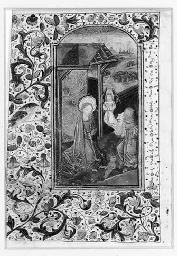
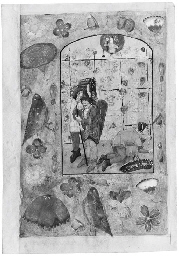





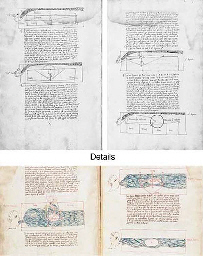
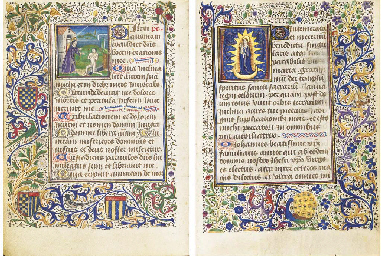
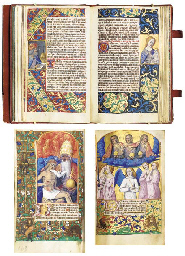



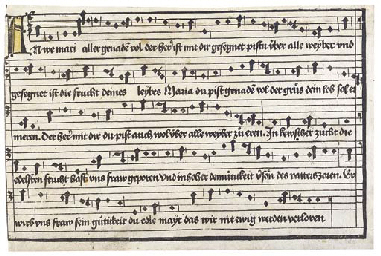
Testen Sie LotSearch und seine Premium-Features 7 Tage - ohne Kosten!
Lassen Sie sich automatisch über neue Objekte in kommenden Auktionen benachrichtigen.
Suchauftrag anlegen